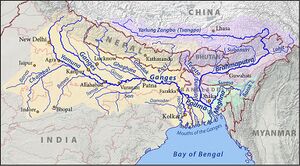Lohit river
| Author:Laxman Burdak, IFS (R) |

Lohit River (लोहित नदी) flows through Arunachal Pradesh and Assam states of India. It is a river in China and India, which joins the Brahmaputra River in the state of Assam. It is also known as the Zayul Chu by the Tibetans and Tellu by the Mishmis[1]
Variants
- Lauhitya/Lauhitya River लौहित्य (AS, p.825) - Lauhitya (लौहित्य) was ancient name of the Brahmaputra River.
- Lohit valley
- Lohit District
- Zayul Chu (by the Tibetans)
- Tellu (by the Mishmis)
Origin of name
Lohita (लोहित) was a Nagavanshi King. Lohita was also a country mentioned in Mahabharata (II.24.16) which was subjugated by Arjuna.
Jat clans
Course
It is formed in the Zayul County of the Tibet Autonomous Region, through a merger of two rivers: the Kangri Karpo Chu (also called Rongto Chu and Zayul Ngu Chu), which originates in the Kangri Garpo range, and Zayul Chu which originates to its northeast. The two rivers merge below the town of Rima.[3] The combined river descends through this mountainous region and surges through Arunachal Pradesh in India for 200 kilometres before entering the plains of Assam where it is known as the Lohit River. Tempestuous and turbulent, and known as the river of blood partly attributable to the lateritic soil, it flows through the Mishmi Hills, to meet the Siang (Brahmaputra) at the head of the Brahmaputra valley.
The Lohit river comes into India from China and flows near India's easternmost inhabited tip, at a place called Kibithu. The Indian Army uses this river for various expeditions and training.
The Dhola–Sadiya Bridge, also referred to as the Bhupen Hazarika Setu, is a beam bridge and longest in India, connecting the northeast states of Assam and Arunachal Pradesh. The bridge spans the Lohit River, from the village of Dhola in the south to Sadiya to the north. Parshuram Kund, a Hindu pilgrimage is situated on the lower reaches of Lohit.
History
Historically, the region between the Lohit River and the Dibang River was known as Sadhayapura as per copper inscriptions.
Lohit district

Lohit (लोहित) is a district in the state of Arunachal Pradesh in India. The district headquarters is located at Tezu. It was known earlier as the Mishmi Hills. The district is named after the Lohit River and consists of the river valley and hills/mountains to the North and South.
History: During medieval times, the present district was under the control of the rulers of the Chutiya Kingdom. The Chutiya rulers controlled the area from the early 13th century to the 16th century and during the 19th century, it became one of the last territories to be brought under British control after the punitive Abor and Mishmi Expedition in the first decade of 20th century.
In June 1980, Dibang Valley district was split from Lohit (and has since been bifurcated again to create the new Lower Dibang Valley district). On 16 February 2004, Anjaw district was carved out from the northern part of Lohit district bordering Tibet and Myanmar, with its headquarters at Hawai. Anjaw was carved out under the Arunachal Pradesh Re-organization of Districts Amendment Bill. Namsai was split from Lohit in 2013.
In Mahabharata
Lauhitya (लॊहित्य) (Tirtha) mentioned in Mahabharata (III.83.2),
Lauhitya (लौहित्य) (River) mentioned in Mahabharata (2-9-26),
Vana Parva, Mahabharata/Book III Chapter 83 mentions names of Pilgrims. Lauhitya (लॊहित्य) (Tirtha) is mentioned in Mahabharata (III.83.2). [4]....Pulastya said, 'Arriving next at the excellent tirtha called Samvedya (संवेद्य) (III.83.1) in the evening, and touching its waters, one surely obtaineth knowledge. Created a tirtha in days of yore by Rama's energy, he that proceedeth to Lauhitya (लॊहित्य)(III.83.2) obtaineth the merit of giving away gold in abundance.
Sabha Parva, Mahabharata/Book II Chapter 9 mentions the Kings Oceans and the Rivers who attended Sabha of Varuna]]. Lauhitya (लौहित्य) (River) is mentioned in Mahabharata (2-9-26). [5].....the Sarayu, the Varavatya, and that queen of rivers the Langali, the Karatoya, the Atreyi, the Lauhitya,....
लोहित नदी
लोहित नदी भारत के अरुणाचल प्रदेश और असम में बहने वाली एक नदी है। यह ब्रह्मपुत्र नदी की एक सहायक नदी है। लोहित नदी पूर्वी तिब्बत के ज़याल छू पर्वतश्रेणी से निकलती है और अरुणाचल प्रदेश में दो सौ किलोमीटर तक तीव्र वेग से बहने के बाद असम के मैदानी क्षेत्र में पहुंचती है। 'खून की नदी' के नाम से जानी जाने वाली यह नदी तूफानी और अशान्त है और इसका यह नाम आंशिक रूप से इसकी लाल मिट्टी के कारण पड़ा है। यह मिश्मी पर्वतमाला से बहती हुई ब्रह्मपुत्र घाटी के मुहाने पर ब्रह्मपुत्र नदी (अरुणाचल प्रदेश में जिसे सियांग नदी के नाम से जाना जाता है) में मिल जाती है।
लोहतगंगा
लोहतगंगा (AS, p.824): ब्रह्मपुत्र तथा लौहित्य नदी को कहा गया है, जो प्राग्ज्योतिषपुर (=गोहाटी, असम) के निकट बहती है। महाभारत, सभापर्व 38 में नरकासुर के वध के प्रसंग में इस नदी का नामोल्लेख है- 'मध्ये लोहितगंगायां भगवान देवकीसुत: औदकायां विरूपाक्षं जघान भरतर्षभ।'. [6]
External links
References
- ↑ Williamson, Noël (1909). "The Lohit-Brahmaputra between Assam and South-Eastern Tibet, November, 1907, to January, 1908". The Geographical Journal. 34: 363–383. doi:10.2307/1777190. JSTOR 1777190. "Tibetans call it the Zayul Chu, and the Mishmi name is Tellu"
- ↑ Jat History Dalip Singh Ahlawat/Parishisht-I, s.n. ल-100
- ↑ Kingdon Ward, F.; Smith, Malcolm (November 1934), "The Himalaya East of the Tsangpo", The Geographical Journal, 84 (5): 369–394,
- ↑ रामस्य च परसादेन तीर्थं राजन कृतं पुरा, तल लॊहित्यं समासाद्य विन्द्याद बहुसुवर्णकम (III.83.2)
- ↑ सरयूर्वारवत्याऽथ लाङ्गली च सरिद्वरा। 2-9-26a, करतोया तथाऽऽत्रेयी लौहित्यश्च महानदः।। 2-9-26b
- ↑ Aitihasik Sthanavali by Vijayendra Kumar Mathur, p.824
Back to Rivers

